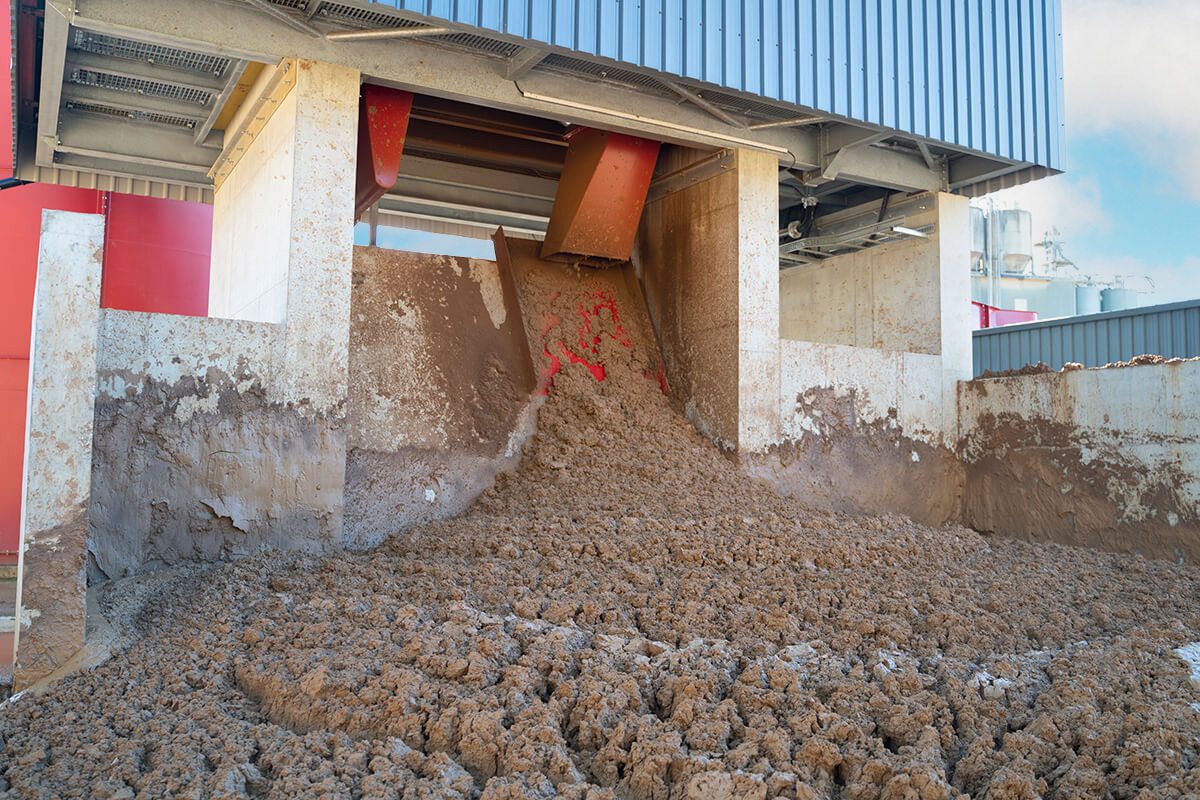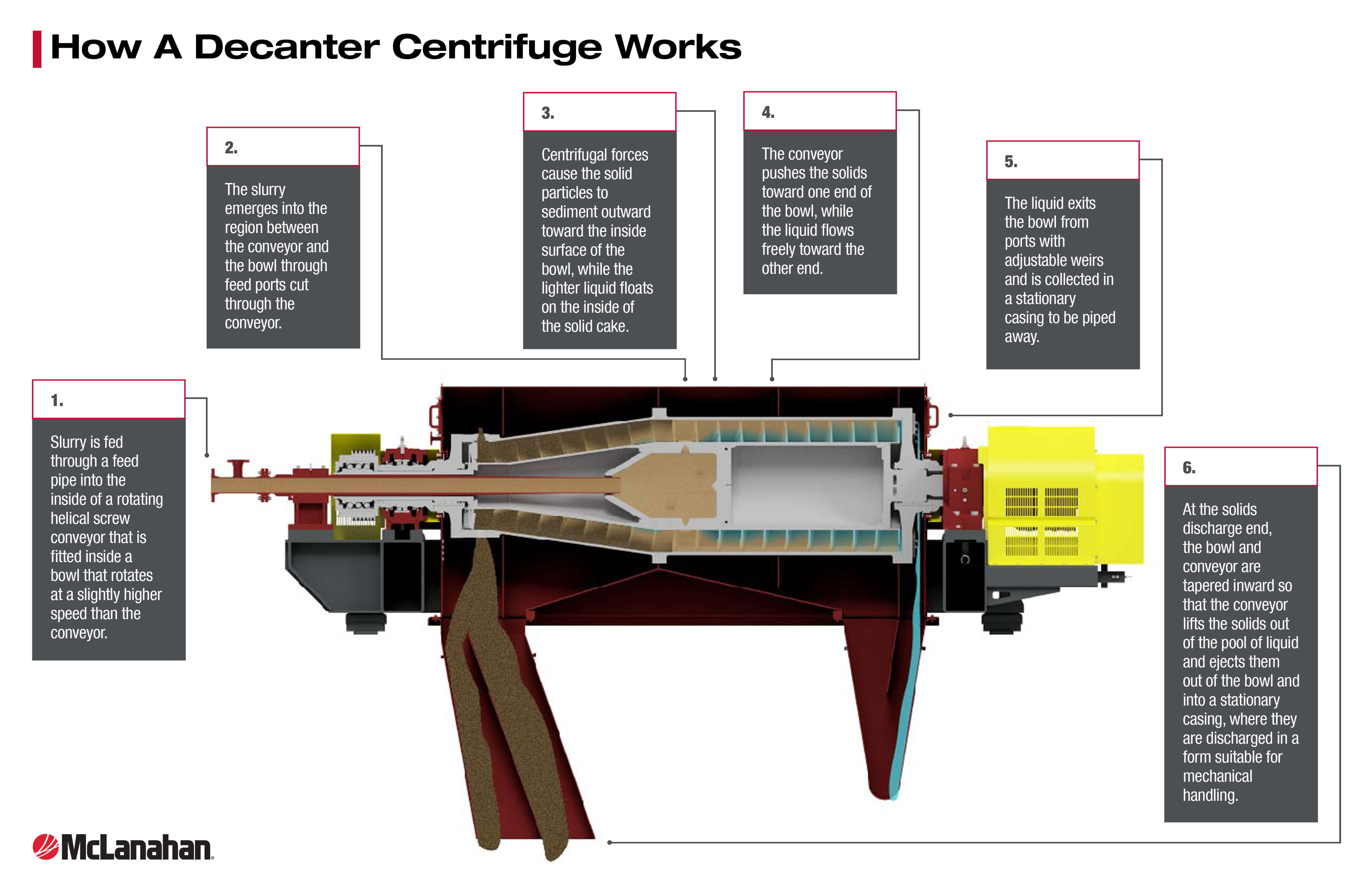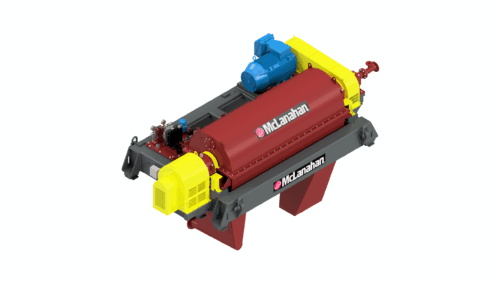What is a Decanter Centrifuge used for?
Decanter Centrifuges are used to separate solids from liquid in a variety of applications. In aggregate processes, one use for Decanter Centrifuges is to handle the tailings in the waste stream. With high centrifugal forces to induce sedimentation, Decanter Centrifuges separate the solid particles from the liquid in a typical waste stream coming from a wet processing plant.
Decanter Centrifuges discharge two products: a liquid that can be reused as process water upstream, and a solids cake that is suitable for mechanical handling.
The main benefit of Decanter Centrifuges for processing tailings in aggregate applications is that they make handling the waste stream easier and more efficient. Processing the waste stream through a Decanter Centrifuge has even allowed some sites to eliminate their settling ponds or lagoons, which can be costly and time-consuming to maintain as well as take up valuable land space.

Solids discharged from a Decanter Centrifuge.
Parts of a Decanter Centrifuge
Decanter Centrifuges feature several main components. They consist of a feed pipe that goes inside a helical screw conveyor that is surrounded by a bowl assembly. These components are then enclosed in a casing, which helps improve housekeeping and reduce noise. Discharge chutes at the bottom of the casing collect the discharged materials
Decanter Centrifuges are supported on a heavy-duty base frame mounted on vibration isolators to minimize vibration and maintain balance.
Other main features of a Decanter Centrifuge include the motors and gearbox, which impart the rotation of the conveyor and bowl assembly necessary for liquid-solid separation.
What is the working principle of a Decanter Centrifuge?
A Decanter Centrifuge uses centrifugal forces to separate solids from liquids at high G’s. The waste stream in the form of a slurry enters the inside of the helical conveyor through the feed pipe. The slurry is then released into the space between the rotating conveyor and the bowl, which is rotating at a higher speed than the conveyor. The solids in the slurry are forced to the wall of the bowl, while the liquid moves freely toward the liquid discharge end of the machine.

Cutaway image showing how a Decanter Centrifuge works.
The liquid exits out ports in the bowl assembly. These feature adjustable weir plates to increase or decrease the radius of the port openings to allow more or less liquid to discharge.
The conveyor moves the solids toward the solids discharge at the opposite end of the machine. The conveyor and bowl are tapered conically at this end to further dewater the solids before they are discharged. The solid cakes are low moisture, and they can be handled with a loader and transported via a truck to a final resting place.
A Decanter Centrifuge operates in a continuous process, meaning material is continuously being fed into it and material is continuously being discharged from it.
How to size a Decanter Centrifuge
Decanter Centrifuges come in a variety of sizes to handle a range of capacities. Like many aggregate and mineral processing machines, Decanter Centrifuges are sized based on the feed and process requirements. The larger the centrifuge, the higher capacity of feed material it can handle and the more tons per hour it will discharge.
Other factors that affect sizing include the speed of the conveyor, the speed of the bowl, the angle of the tapered beach area and the pitch of the conveyor.
How much does a Decanter Centrifuge cost?
Decanter Centrifuges are available in a range of sizes and capacities. Because of this, the cost of a Decanter Centrifuge can vary enormously depending on the type and size of centrifuge needed to fit the application requirements. Once a duty is determined, the manufacturer will be able to select a suitable model and provide cost and cost benefit information accordingly.
The operational costs can vary depending on the size of the machine and how much power is necessary to process the material to the desired outcome. Power costs, too, can vary depending on location and energy supplier.
Depending on the material being processed and the goals of the site, chemicals may need to be added to the feed to aid in sedimentation. This will increase the operational costs of a Decanter Centrifuge.
Decanter Centrifuges are fully automated, meaning they require minimal operator intervention, so labor costs will be less with these machines compared to other mechanical dewatering devices such as Belt Presses.

Decanter Centrifuge
How to maintain a Decanter Centrifuge
Decanter Centrifuges are relatively low-maintenance machines. For the most efficient operation, they should be regularly inspected and maintained according to the manual.
Inspections should be carried out before the centrifuge is started up every day, and more in-depth inspections should take place every 2,000, 4,000, 8,000, 16,000 and 40,000 hours of operation (or every three months, six months, year, two years and five years, respectively). These inspections range from visual checks for wear or damage or loose components to lubricating the bearings. The bearings need to be lubricated at regular intervals, which are outlined in the operation and maintenance manual.
If inspections reveal components need to be repaired or replaced, do so immediately by following the replacement procedures listed in the manual. Be sure to follow all safety guidelines outlined in the manual and to heed all machine warning labels and site-specific safety measures. If you need assistance, call your local dealer or manufacturer for help making the necessary repairs or replacements.
Also, be sure to keep a stock of spare parts at your facility to minimize downtime when replacement of a component is necessary.
Optimizing a Decanter Centrifuge
Depending on the goals of the site, optimizing a Decanter Centrifuge can mean producing a drier solid product or a clearer liquid.
If drier solids are desired, adjustments can be made to:
- decrease the pool depth and increase the dry deck area.
- increase the rotational speed of the machine.
- move the feed position closer to the liquid end of the bowl.
If improved liquid clarity is the goal, adjustments can be made to:
- increase the pool depth.
- increase the rotational speed.
- move the feed position closer to the solids end of the bowl.
- dilute the feed slurry.
- reduce the feed rate.
- add chemicals to improve settling.
More information about how to accomplish these different tasks can be found in the centrifuge manual.
Decanter Centrifuges are a great option for dewatering tailings in aggregate applications to a low-moisture content suitable for mechanical handling. They are fully automated, low-maintenance, compact machines that can be adjusted to improve the solids dryness or liquid clarity, depending on the goals of the site.






